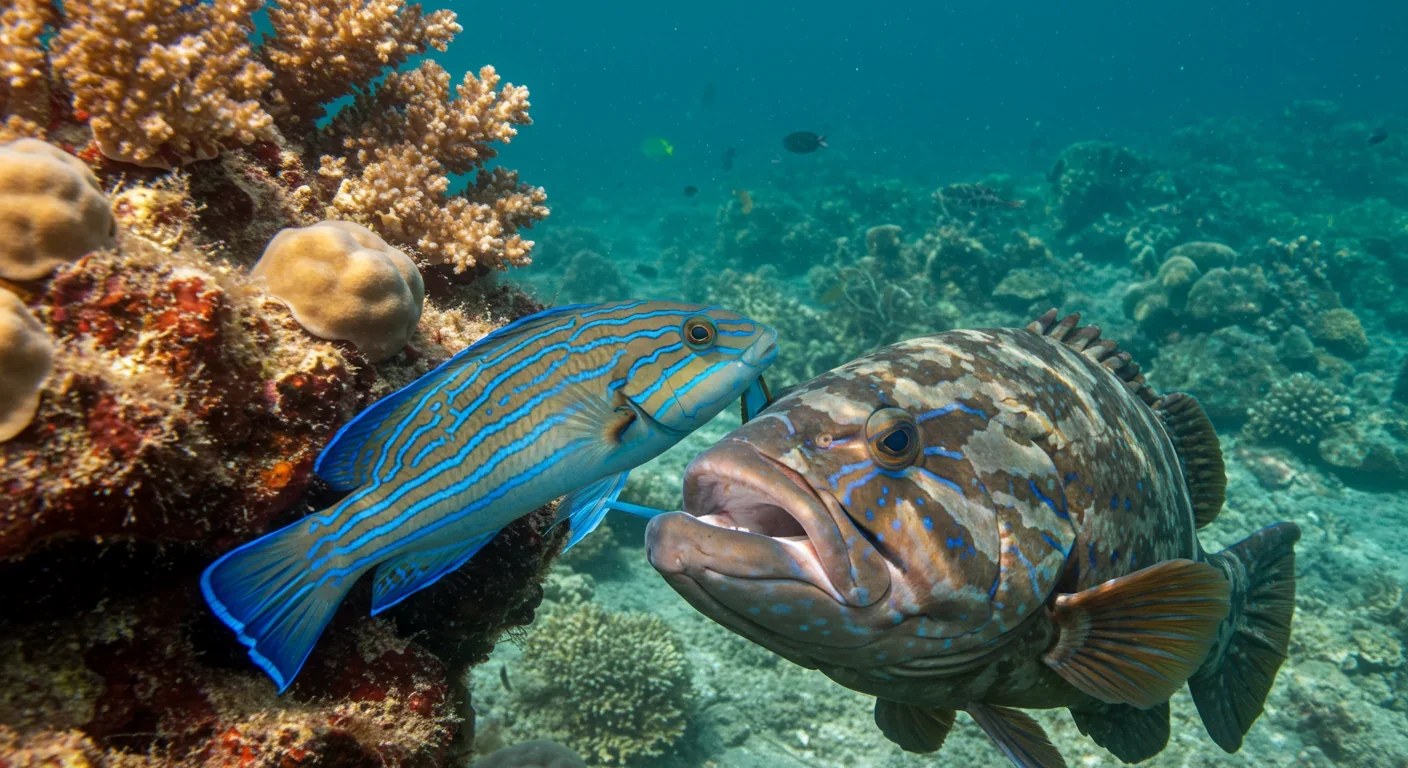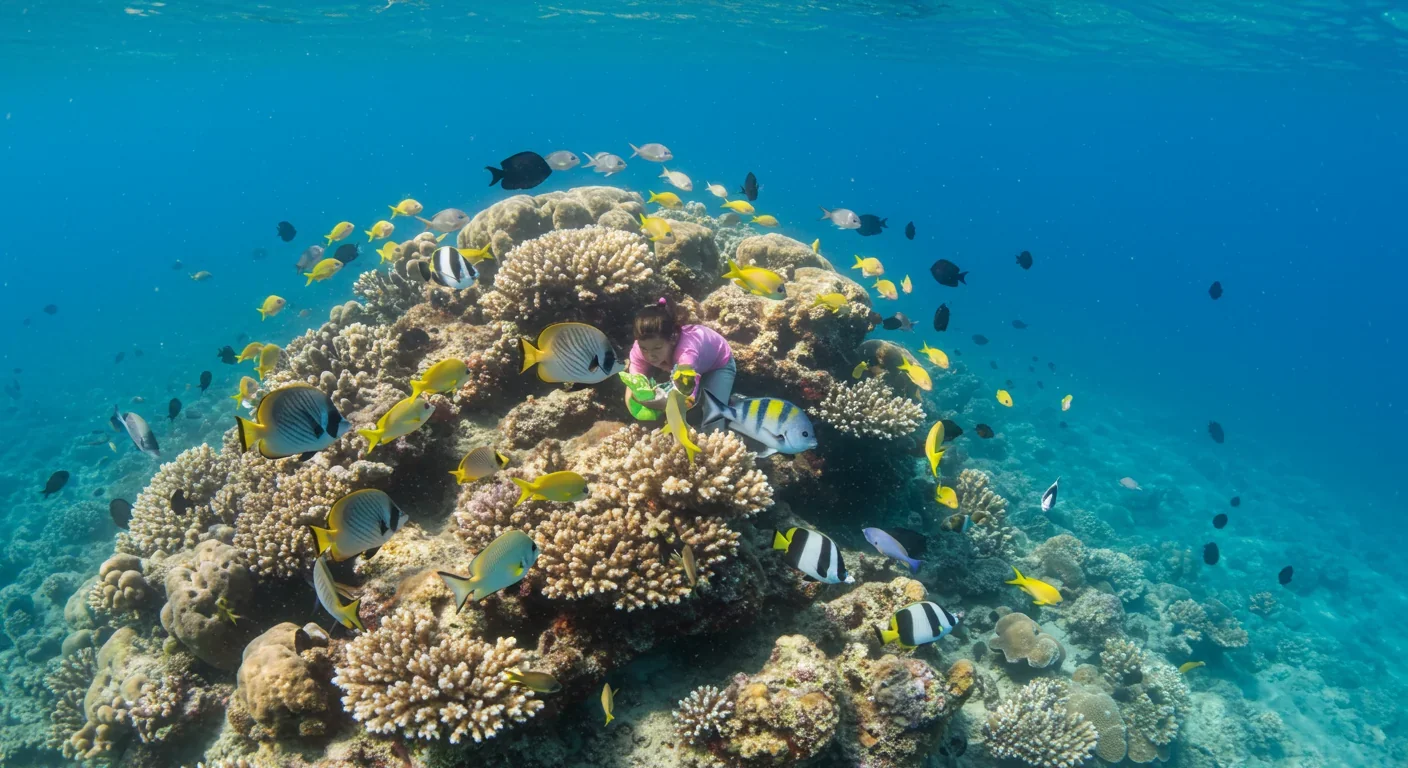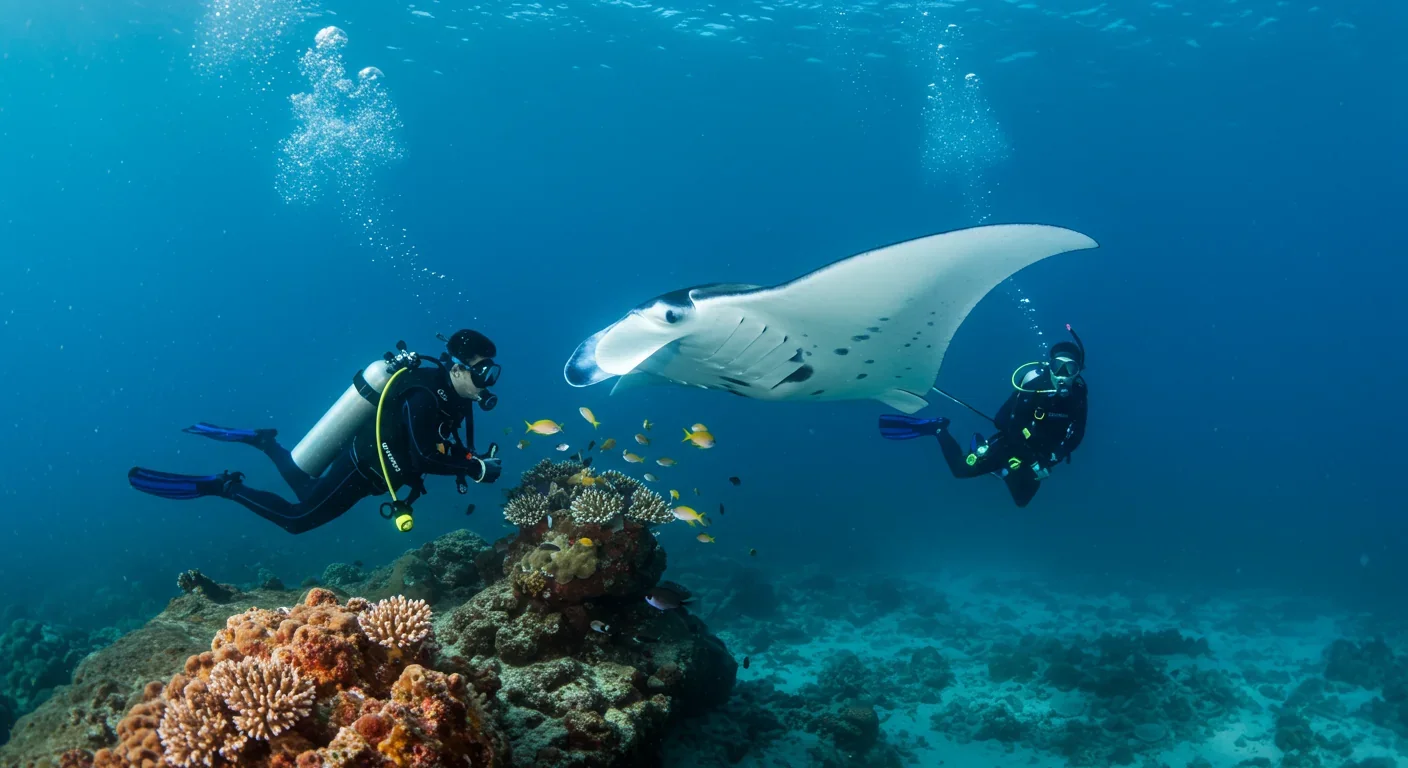Forest Biological Clocks: Ecosystems That Keep Time

TL;DR: Cleaner fish stations are underwater service hubs where tiny wrasses, gobies, and shrimp remove parasites from larger reef fish in sophisticated symbiotic partnerships that maintain entire ecosystem health across tropical reefs.

Picture a busy intersection on the reef where fish queue up like cars at a service station. A tiny wrasse or goby darts around a grouper three times its size, picking off parasites with surgical precision. The grouper hovers patiently, sometimes opening its mouth wide to let the cleaner swim inside and work on its gills. This isn't a scene from a nature documentary—it's happening right now on coral reefs from the Red Sea to the Great Barrier Reef, and it's keeping entire ecosystems healthy.
These underwater service stations are called cleaner fish stations, and they're far more sophisticated than they first appear. The fish running them—primarily bluestreak cleaner wrasses and various goby species—have evolved intricate behaviors, visual signals, and even what scientists call "dances" to attract clients and negotiate the terms of service.
Cleaner fish belong to two main categories: obligate cleaners who dedicate their entire lives to the work, and facultative cleaners who clean part-time when it suits them. The bluestreak cleaner wrasse (Labroides dimidiatus) is the most famous obligate cleaner, sporting a distinctive blue horizontal stripe that acts as living advertising. Research shows that larger predatory fish recognize this stripe and refrain from eating the cleaners, understanding they provide a valuable service.
When a client fish approaches a cleaning station, the cleaner performs a distinctive greeting dance—moving its rear end up and down in what researchers describe as an invitation. This isn't just for show. The dance signals to the client that it's safe to stop, hover, and even open its mouth for internal cleaning. Cleaner wrasses will swim straight into the mouths of moray eels and other predators, trusting the implicit agreement that protects them.
But size isn't the only cue at play. A recent study on cleaner gobies found that 77% of test subjects could successfully identify which "clients" had more parasites based solely on visual size cues. The cleaners couldn't learn to use color or spatial location as reliable indicators, which suggests their brains have evolved specifically to assess client size—a proxy for parasite load in the wild.
The cleaning relationship extends beyond fish. Pacific cleaner shrimp (Lysmata amboinensis) congregate at stations alongside fish cleaners, performing their own rocking dance to signal availability. Despite having coarse vision and being colorblind, these shrimp rely on chemical or tactile cues to identify clients. They remove parasites, dead tissue, and even aid wound healing in injured fish, providing medical services that go far beyond simple grooming.
At any given station, you might find different social structures. Some are run by groups of juvenile wrasses, others by mated pairs, and still others by a dominant male with a harem of females. Here's where it gets interesting: if the dominant male dies, the largest female will change sex to become male, ensuring the station continues operating without interruption.
This sex-changing ability highlights how critical these stations are. They can't afford downtime. Client fish depend on regular cleaning to manage parasite loads, and the entire reef community suffers when stations close.
The service itself is remarkably thorough. Cleaners remove ectoparasites, dead skin, mucus, and infected tissue from their clients' bodies, fins, and gills. At cleaning stations in Egypt's Ras Mohamed Nature Reserve, researchers documented cleaner wrasses feeding primarily on parasites from brown surgeonfish and white belly damselfish. Fish with regular access to cleaners showed lower antibody responses than those without access, suggesting that frequent cleaning reduces the need for active immune responses.
But the relationship isn't always perfectly mutualistic. Sometimes cleaners "cheat" by taking bites of protective mucus or healthy tissue instead of just parasites. This creates tension in the partnership. Juvenile cleaners are more likely to bite clients than adults, which could explain why some client fish show preference for established, adult-run stations.

Individual cleaning interactions might seem small, but they add up to ecosystem-scale effects. When researchers experimentally removed cleaning gobies from stations on Caribbean reefs in Puerto Rico and St. Croix, they observed changes in both fish behavior and microbial communities in the surrounding water.
More fish visited sites that still had cleaners. The presence of cleaners influenced not just the fish they serviced directly, but the entire local microbial environment. Lead author Anya Brown noted that cleaner fish influence damselfish and reef microbial diversity, though the extent varies by substrate type and specific reef conditions. Each reef carries a unique microbial signature, and cleaners appear to act as hubs for microbial movement, potentially transporting both beneficial bacteria and pathogens across communities.
This raises fascinating questions about whether cleaning stations help spread beneficial microbes that boost coral and fish health, or whether they create hotspots for disease transmission. The answer is probably both, depending on what pathogens are present in the system.
On the Great Barrier Reef, bluestreak cleaner wrasses show remarkable dietary flexibility. In tidal environments, they function as facultative cleaners that feed more on corals than on fish clients, shifting their diet based on what's available. This adaptability helps them survive environmental fluctuations but means cleaning services may be less reliable in these zones.
Cleaner fish stations exist throughout the tropics, but certain regions stand out. The Indo-Pacific, from Eastern Africa and the Red Sea to French Polynesia, hosts the highest diversity of cleaner species. In these waters, you'll find not just cleaner wrasses and gobies, but also cleaner shrimp, creating multi-species stations that offer comprehensive services.
The Red Sea's clear, warm waters make it a particularly important laboratory for studying cleaner fish. The region's shallow reefs allow for easy observation, and the diversity of client species—from tiny damselfish to large groupers—provides a full spectrum of cleaning interactions to study.
The Great Barrier Reef, stretching over 2,300 kilometers along Australia's northeast coast, contains thousands of cleaning stations. Here, the relationship between cleaners and clients has evolved in a uniquely complex ecosystem where coral, fish, and invertebrate populations are tightly interconnected. What affects one group ripples through the others.
Caribbean reefs host different cleaner species adapted to local conditions, but the fundamental service remains the same. Cleaner gobies and other species maintain stations that act as healthcare centers for reef fish populations already stressed by warming waters and disease.
The aquarium trade poses one of the most direct threats to cleaner fish populations. Bluestreak cleaner wrasses are notoriously difficult to keep in captivity because they struggle to adapt to prepared foods. Most die within months of capture. Yet they remain popular in the trade, leading to continuous harvesting from wild reefs.
While there's currently no evidence that cleaner shrimp collection has impacted natural populations, the concern exists. Most shrimp sold commercially are wild-caught, and if collection intensifies, key cleaning stations could lose their operators.
Climate change presents an even larger threat. As ocean temperatures rise, coral bleaching events become more frequent. When corals die, the physical structure of the reef degrades, eliminating the crevices and formations where cleaning stations typically establish. Warming waters also stress fish immune systems, potentially increasing parasite loads right when cleaning services become less available.
Ocean acidification affects the entire reef food web. If prey species that cleaners depend on when client fish are scarce decline or disappear, cleaners may abandon their stations to search for food elsewhere. The dietary flexibility of some cleaner species might help them survive, but it could mean reduced cleaning services for client fish that desperately need them.
Coastal development, pollution, and overfishing compound these problems. When large predator populations collapse due to overfishing, the ecosystem balance shifts. Client fish that depend on cleaning services may become more vulnerable to disease without natural predator pressure to keep their populations in check. Meanwhile, nutrient runoff from coastal development can trigger algal blooms that smother corals and disrupt the visual and chemical cues that cleaning stations rely on.

The value of cleaning stations has spawned an evolutionary arms race. Some species, like the bluestreak fangblenny (Plagiotremus rhinorhynchos), have evolved to mimic cleaner wrasses almost perfectly. They sport the same blue stripe and similar movement patterns. But instead of removing parasites, they dart in and tear small chunks of flesh from unsuspecting clients.
This mimicry puts pressure on client fish to become better at distinguishing real cleaners from imposters. It also creates a challenge for genuine cleaners, who must work to maintain their reputation. Any cleaner that cheats too often risks losing clients to competitors or being confused with dangerous mimics.
The evolutionary pressures work in multiple directions simultaneously. Cleaners evolve better signals to distinguish themselves from mimics. Clients evolve better recognition abilities. Mimics evolve more convincing disguises. And all of this happens against the backdrop of changing environmental conditions that favor different strategies at different times.
Not all the news is grim. Several marine protected areas have successfully maintained healthy cleaner fish populations by restricting collection and preserving reef habitat. Egypt's Ras Mohamed Nature Reserve, where researchers study cleaner wrasse interactions with surgeonfish and damselfish, has benefited from decades of protection.
Australia's Great Barrier Reef Marine Park, despite facing massive climate challenges, maintains extensive no-take zones where cleaner fish populations can thrive without fishing pressure. These zones serve as population sources that can potentially replenish degraded areas.
Captive breeding programs have made some progress. Successful hatchery production of bluestreak cleaner wrasses could reduce pressure on wild populations if aquarium hobbyists shift to captive-bred specimens. The challenge lies in scaling up production and making captive-bred fish affordable enough to compete with wild-caught individuals.
Some coral restoration projects now consider cleaner fish habitat needs when designing artificial reef structures. By creating caves, overhangs, and complex formations similar to natural reefs, these projects provide places where cleaning stations can establish and operate.
Supporting marine protected areas through donations or volunteer work helps ensure cleaning stations have safe havens. Organizations working on coral restoration need funding and public support to continue their work.
If you keep a saltwater aquarium, choosing captive-bred fish over wild-caught specimens reduces pressure on reef populations. Many cleaner species simply don't survive in aquariums anyway, so avoiding them altogether is the most conservation-friendly choice.
Reducing your carbon footprint helps combat the climate change that threatens all reef ecosystems. The connection might seem distant, but every increment of ocean warming or acidification makes life harder for the intricate partnerships that cleaning stations represent.
When you visit coral reefs, choose operators who follow responsible wildlife viewing guidelines. Don't touch or feed fish, and maintain respectful distances from cleaning stations. These interactions evolved over millions of years without human interference, and they work best when we observe rather than participate.
Cleaning stations represent something profound: proof that cooperation, specialized services, and mutual benefit can emerge naturally from evolutionary pressures. These tiny fish and shrimp, working their stations day after day, maintain the health of creatures hundreds of times their size. They've built an economy based on trust, signaling, and reciprocal benefits.
The partnerships at cleaning stations aren't guaranteed to survive the rapid changes humans are imposing on ocean ecosystems. Rising temperatures, acidifying waters, and direct exploitation could unravel millions of years of coevolution. But they might also prove more resilient than we expect. The sex-changing abilities of some cleaner wrasses, the dietary flexibility that lets them survive when client fish are scarce, and the multiple species that can fill cleaning niches all suggest adaptability.
What's certain is that we're only beginning to understand the full importance of these underwater service stations. The recent discovery that they influence reef microbial communities hints at roles we haven't even imagined yet. Every cleaning interaction might be reshaping the invisible ecosystem of bacteria and other microbes that underpin reef health.
The ocean's natural car washes deserve our attention and protection, not just for their intrinsic value but for what they teach us. They show that complex, mutually beneficial relationships can evolve and persist when conditions allow. They demonstrate that even the smallest creatures can play outsize roles in maintaining ecosystem health. And they remind us that what seems simple on the surface—a little fish picking parasites off a big fish—can be extraordinarily complex and valuable once you look closer.
Next time you see footage of a cleaner wrasse servicing a grouper, remember you're watching an ancient partnership that helps keep coral reefs functioning. You're seeing evolution in action, cooperation under the sea, and a system that exists nowhere else in nature. You're seeing something worth saving.

MOND proposes gravity changes at low accelerations, explaining galaxy rotation without dark matter. While it predicts thousands of galaxies correctly, it struggles with clusters and cosmology, keeping the dark matter debate alive.

Ultrafine pollution particles smaller than 100 nanometers can bypass the blood-brain barrier through the olfactory nerve and bloodstream, depositing in brain tissue where they trigger neuroinflammation linked to dementia and neurological disorders, yet remain completely unregulated by current air quality standards.

CAES stores excess renewable energy by compressing air in underground caverns, then releases it through turbines during peak demand. New advanced adiabatic systems achieve 70%+ efficiency, making this decades-old technology suddenly competitive for long-duration grid storage.

Our brains are hardwired to see patterns in randomness, causing the gambler's fallacy—the mistaken belief that past random events influence future probabilities. This cognitive bias costs people millions in casinos, investments, and daily decisions.

Forests operate as synchronized living systems with molecular clocks that coordinate metabolism from individual cells to entire ecosystems, creating rhythmic patterns that affect global carbon cycles and climate feedback loops.

Generation Z is the first cohort to come of age amid a polycrisis - interconnected global failures spanning climate, economy, democracy, and health. This cascading reality is fundamentally reshaping how young people think, plan their lives, and organize for change.

Zero-trust security eliminates implicit network trust by requiring continuous verification of every access request. Organizations are rapidly adopting this architecture to address cloud computing, remote work, and sophisticated threats that rendered perimeter defenses obsolete.